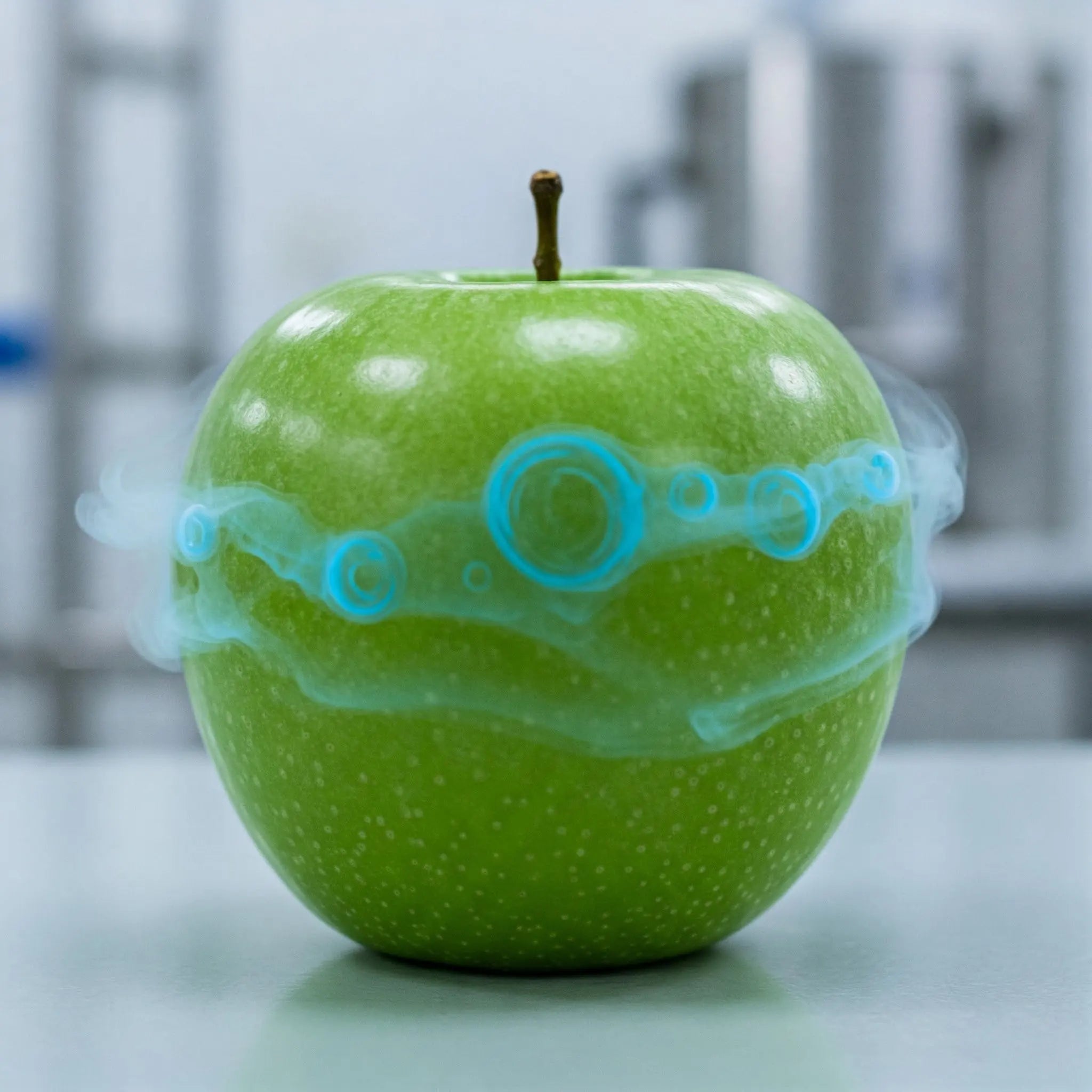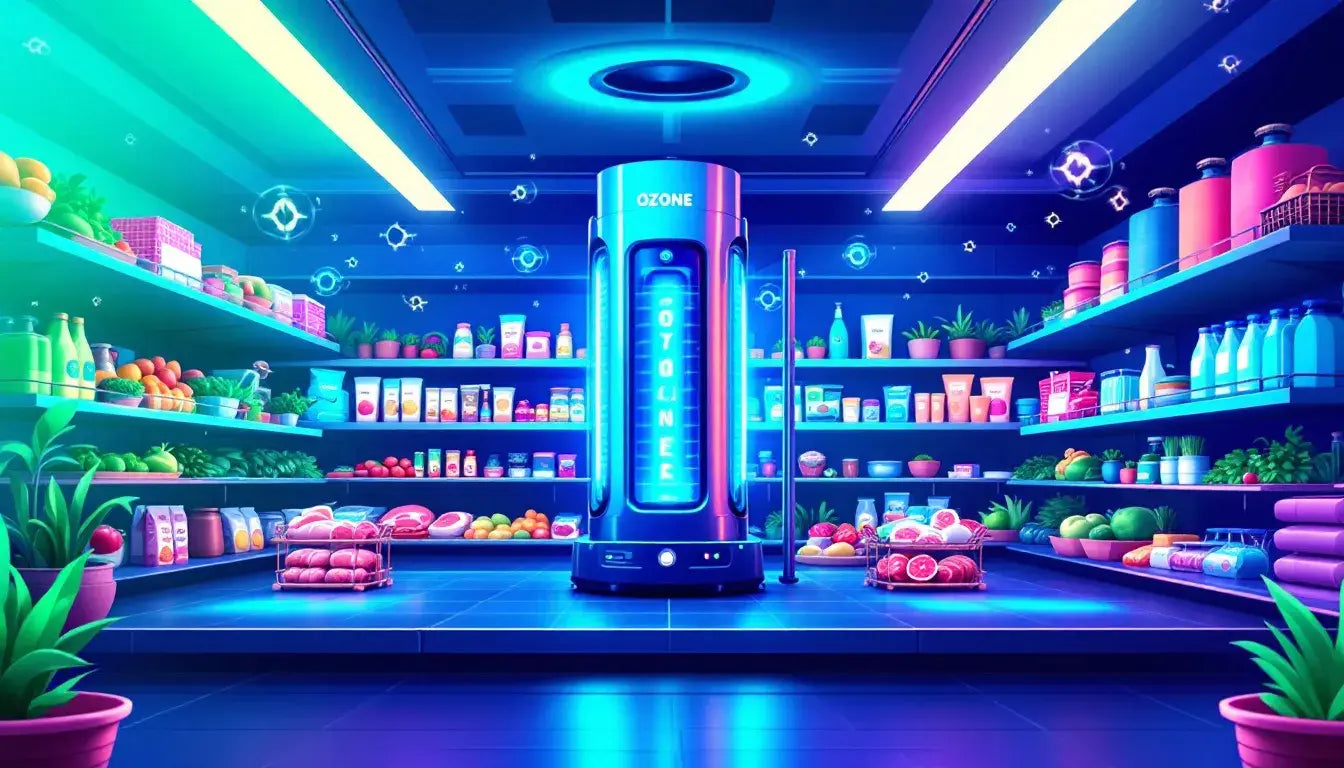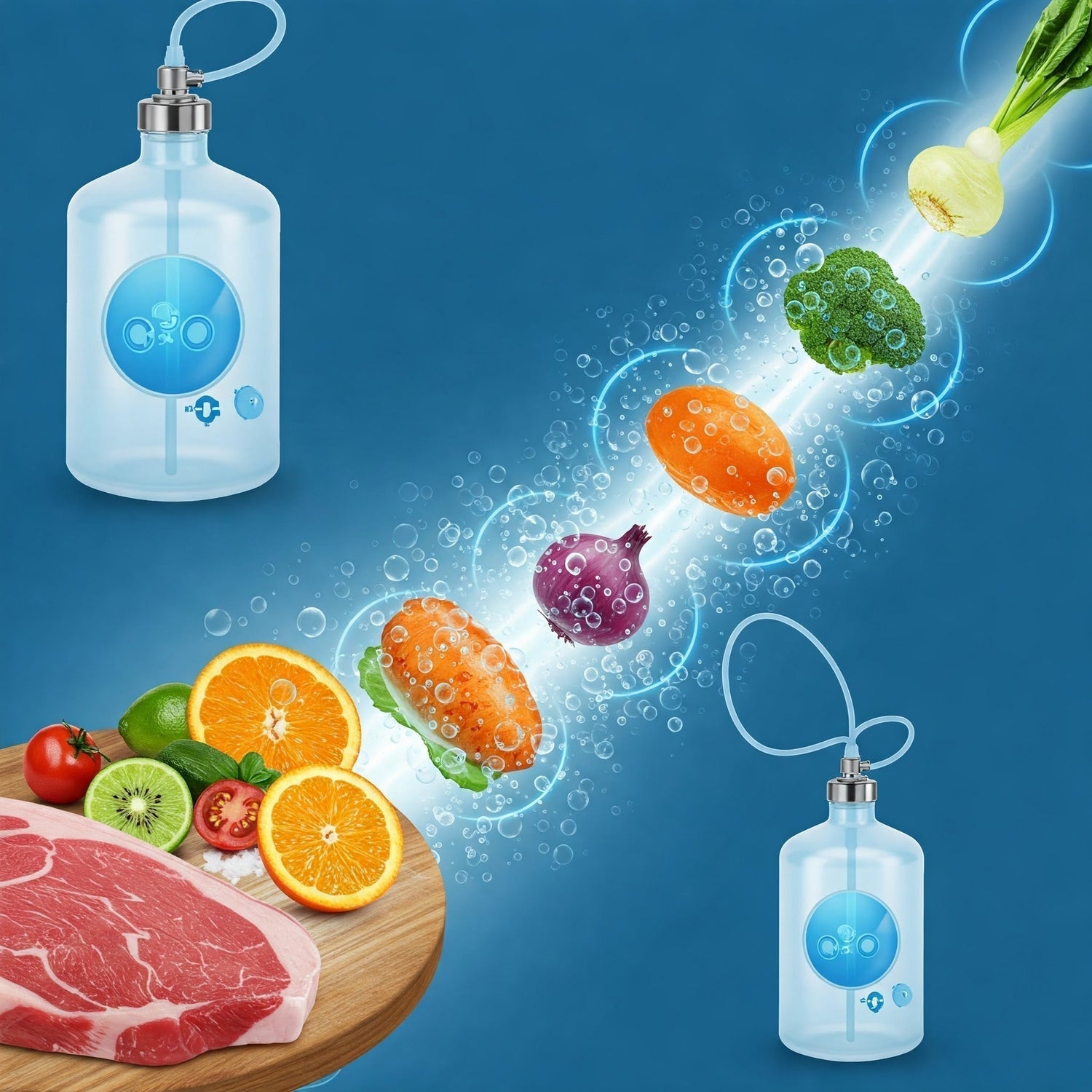Ozone for food enhances safety and extends shelf life by eliminating bacteria, viruses, and fungi. We’ll explore how ozone treatment works, its benefits, ozone effectiveness, and safe use in food processing in this article.
Introduction
Ozone treatment is a widely used technology in the food industry for food preservation and safety. As a powerful oxidant, ozone can effectively control microbial growth and extend the shelf life of various food products. The use of ozone in the food industry has been increasing in recent years due to its effectiveness and eco-friendliness. Unlike traditional chemical sanitizers, ozone decomposes into oxygen, leaving no harmful residues behind.
Ozone treatment is particularly promising for the preservation of fresh vegetables, offering several advantages over conventional methods. It is a natural and non-toxic sanitizer that can control the growth of microorganisms, extend the shelf life of produce, and preserve the nutritional and sensory qualities of fresh vegetables. This makes ozone an attractive option for food processors looking to enhance food safety and quality while minimizing environmental impact.
Key Takeaways
-
Ozone treatment effectively eliminates a wide range of microorganisms in the food industry, enhancing food safety and shelf life without leaving harmful residues.
-
The Milerd Detoxer utilizes advanced ozone technologies and ultrasound technology for efficient food decontamination, achieving over 96% efficiency in removing harmful substances.
-
Regulatory standards classify ozone as Generally Recognized As Safe (GRAS) for food applications, necessitating careful control of ozone concentrations to ensure safety for both consumers and workers.
Understanding Ozone Treatment in the Food Industry

Ozone, a compound made up of three oxygen atoms, is renowned for its strong disinfecting properties and is widely utilized across various sectors for its antimicrobial effects. Within the realm of the food industry, ozone treatment has become notable due to its robust ability to eradicate an extensive range of microbes such as bacteria, viruses, and fungi. By using an on-site ozone generator, this process can be significantly enhanced ensuring effective cleansing.
The trio of oxygen atoms within ozone molecules play a critical role in their potent sanitation capabilities. Upon contact with microbes, these oxygen-rich molecules instigate oxidation processes that breakdown cellular structures leading to microbial destruction. Ozone’s prowess as a biocide lies in this action mechanism which obstructs microorganisms from developing immunity against it.
A multitude of factors influence how effective ozone treatments are. Notably include the concentration levels of ozone used during exposure times based on different foods being treated can have varying results requiring careful adjustment between them so not diminish overall quality while still providing efficient deactivation pathogens present. Gaseous ozone exposure has been shown to enhance the storage quality and shelf-life of various food products, including vegetables and meats, by influencing microbial inactivation and quality preservation.
Utilized in both gaseous form—commonly dispensed through methods like spraying over or immersing foods—and aqueous solution—for cleaning food processing apparatuses surfaces—ozone provides substantial versatility addressing hygiene maintaining safety standards operations related industries. Ozone exposure, particularly in treatments of vegetables like carrots and lettuce, significantly reduces microbial loads, enhancing shelf life and safety.
When applied in food-related settings, decomposes rapidly back into pure leaving behind residual substances making use of an ideal option compared conventional sanitizing agents wanting to avoid potential chemical contamination of consumables thus reinforcing position preferred choice among alternative options available today.
Physico-Chemical Properties of Ozone
Ozone is a triatomic molecule consisting of three oxygen atoms, giving it the chemical formula O3. This unique structure endows ozone with a high oxidation-reduction potential, making it one of the most powerful oxidants available. Its high reactivity allows ozone to interact with a wide range of organic and inorganic compounds, effectively breaking down contaminants and pathogens.
One of the key advantages of ozone is its strong antimicrobial effect. Ozone can inactivate a broad spectrum of microorganisms, including bacteria, viruses, and fungi, by oxidizing their cellular components. This makes it an effective non-thermal disinfectant, capable of sanitizing food and surfaces at low temperatures without compromising its effectiveness. The ability to use ozone at low temperatures is particularly beneficial for preserving the quality and nutritional value of perishable foods.
Ozone Generation and Transfer
Ozone can be generated through various methods, including corona discharge, UV light, and electrolysis. Among these, corona discharge is the most common method used in the food industry. This process involves passing a high-voltage electrical discharge through a gas, typically oxygen, to produce ozone. The efficiency of ozone generation depends on the type of equipment used and the operating conditions, such as temperature and humidity.
Once generated, ozone can be transferred to food products either as a gas or dissolved in water. Gaseous ozone is often applied through methods like spraying or immersing foods, ensuring thorough contact with the entire surface. Aqueous ozone, produced by dissolving ozone gas in water, is particularly effective for sanitizing food processing equipment and non-food contact surfaces. This versatility in application methods allows ozone to address various hygiene needs in the food processing environment.
Types of Ozone Applications in Food Processing

Ozone can be applied in various forms to achieve optimal results in food processing. The primary forms—gaseous and aqueous ozone—each have unique applications and benefits.
Generated on-site using ozone generators, gaseous ozone treatment can be applied through spraying or bathing foods to enhance sanitation. This approach is especially effective for solid foods, ensuring thorough contact with the entire surface. Gaseous ozone concentration and exposure time are critical factors in determining the effectiveness of this treatment.
Aqueous ozone is produced by dissolving ozone gas in water. This form of ozone is particularly effective as a sanitizer for food processing equipment and non-food contact surfaces, helping to maintain hygiene in the food processing environment. Aqueous ozone treatments are commonly used in washing and sanitizing fruits, vegetables, and other perishable items.
Both gaseous and aqueous ozone applications significantly enhance food safety and sanitation in the food processing industry. Ozone inactivates microorganisms by oxidizing their cellular components, making it a broad-spectrum biocide that does not allow pathogens to develop resistance. Thus, ozone effectively controls microbial contamination in various food products.
A unique advantage of ozone is its decomposition into oxygen, leaving no harmful residues. This ensures ozone-treated foods are safe and residue-free, making them a preferable alternative to traditional sanitizers. In comparison, hydrogen peroxide is another conventional antimicrobial solution used to disinfect fresh-cut fruits and vegetables, but it may leave chemical residues that pose potential health risks.
The versatility of ozone applications extends beyond food processing. Ozone is also used in water and wastewater treatment, highlighting its effectiveness as a disinfectant in various settings. The ability to generate ozone on-site using ozone generators adds to its practicality and convenience in the food industry.
Benefits of Ozone Technology for Food Safety

Ozone technology offers a plethora of advantages for maintaining food safety, making it an essential tool in the food industry. Its primary benefit lies in its capacity to eradicate a vast range of pathogens that cause foodborne illnesses including bacteria, viruses, and fungi. Thanks to its wide-ranging biocidal action, ozone is adept at managing microbial contamination across different types of food products.
The ability of ozone to significantly lower microbial counts on both foods and processing equipment bolsters overall food safety. The strong oxidizing properties possessed by ozone deactivate dangerous microorganisms effectively mitigating the likelihood of outbreaks caused by contaminated foods. Enhanced levels of ozone have been associated with higher rates of pathogen inactivation, solidifying the dependability of ozone treatment as a method for safeguarding against health risks. Research supporting these benefits can be found in studies such as doi 10.1016.
Through minimizing microbial contamination, using this approach can prolong how long fresh produce retains its freshness — extending shelf life especially when it comes to perishables such as fruits and vegetables or meats which benefits not only safety but also conserves their aroma and flavor while stored.
In settings where cold storage is used too, employing ozonation proves beneficial. It keeps low microbiological populations without having recourse to chemical preservatives typically employed for lengthening product viability—presenting itself as an eco-conscious choice within preservation practices found today.
Boosting antimicrobial efficacy often involves integrating ozonation with alternative techniques leading to superior maintenance concerning quality facets inherent in various kinds of bacteria. Of edibles—for instance, coupling thermal treatments along side using aqueous solutions infused via o-zone may achieve greater reductions pertaining particularly towards infectious agents present therein.
Nonetheless, careful attention must be paid to potential creation stemming from unwanted substances secondary to them. To interactions—despite assurance provided. By the capabilities seen amongst ozone usage, adequate management regarding concentration and duration necessary during exposures cannot be overstated. In guaranteeing aforementioned implementations remain benign thus preserving consumer wellbeing.
Gaseous Ozone Concentration and Food Safety
Gaseous ozone concentration is a critical factor in determining the effectiveness of ozone treatment. Higher ozone concentrations can lead to a more rapid inactivation of microorganisms, enhancing food safety. However, it is essential to balance this with the potential for oxidation of certain food compounds, which can affect taste, texture, or nutritional content.
The optimal ozone concentration for food safety depends on several factors, including the type of food, the desired level of microbial inactivation, and the exposure time. For instance, delicate fruits may require lower ozone concentrations to avoid damage, while more robust items can withstand higher levels. The Environmental Protection Agency (EPA) has established a maximum concentration permitted in air of 0.08 ppm for human exposure in ozonated air over an 8-hour period. Adhering to these guidelines ensures that ozone treatment remains safe for both consumers and workers.
By carefully controlling ozone concentrations and exposure times, the food industry can harness the benefits of ozone treatment to enhance food safety and extend shelf life without compromising quality.
Enhancing Shelf Life with Ozone Treatments

Utilizing ozone treatments in the food process provides considerable benefits by extending the storage life of a wide array of edibles. Ozone’s main role in this extension is to minimize foods’ microbial load, effectively preventing spoilage organisms from proliferating. Consequently, this action not only prolongs the shelf life, but also amplifies food safety.
Ozone effectiveness varies depending on factors such as microbial strain, application method, the food matrix, and other intrinsic parameters. Studies demonstrate significant differences in the effectiveness of ozone treatment on different pathogens, emphasizing the importance of tailored ozone concentrations and treatment conditions to achieve desired microbial reductions.
In its action against ethylene gas—emitted by maturing fruits, which promotes faster ripening and subsequent spoilage—ozone plays a vital role. By eliminating ethylene, ozone curtails the quick deterioration process, thereby sustaining both produce freshness and quality for longer durations.
Ozone treatment stands out because it does not leave behind any chemical residues on treated sustenance since ozone breaks down into oxygen quickly after use. This characteristic renders it an eco-friendly choice compared to traditional sanitizers known for their potential residual impact that can compromise both food safety and integrity.
When incorporated as part of hurdle technology—a strategy that entails combining several preservation approaches—the effectiveness of ensuring safe consumption and longevity is enhanced further. Integrating various methods such as refrigeration or modified atmosphere packaging alongside ozone treatment aids processors in achieving superior standards of food quality and security.
Regulatory Standards and Safety Considerations
Established regulations are vital for the secure application of ozone in the food industry. The FDA has recognized ozone as Recognized As Safe (GRAS) when it comes to its use in treating food, allowing it to act as an antimicrobial agent both in water and gas states during processing.
The Food Safety Modernization Modernization. Act obligates adherence to safety protocols that inhibit microbial contamination, such as those involving ozone usage. Ozone exposure has been shown to enhance the shelf life and safety of vegetables like carrots and lettuce by significantly reducing microbial loads, making them suitable for immediate marketing. For the protection of employees, the National Institute for Occupational Safety and Health advises a maximum workplace exposure limit to gaseous ozone of 0.10 ppm.
Worker exposure limits set by the Occupational Safety and Health Administration stipulate that individuals should not be subject to gaseous ozone levels exceeding 0.10 parts per million during any given eight-hour shift. This precautionary measure aims at averting potential adverse health effects like respiratory problems or lung damage due to elevated concentrations of this substance.
Limits on pesticide residues fall under EPA regulation, which also prescribes national standards pertinent to maintaining air quality—ozone concentration included within these benchmarks—to assure safe yet effective utilization of ozone within food processes while safeguarding consumer welfare alongside occupational health.
The Milerd Detoxer: Revolutionizing Food Decontamination

The Milerd Detoxer stands as a considerable breakthrough in the technology used for decontaminating food. It employs a combination of ozone and ultrasound technologies to detoxify and disinfect, thus securing its safety for consumption. This pioneering equipment merges ozone’s robust anti-microbial effects with the thorough cleansing power of ultrasound, delivering an all-encompassing solution to ensure food is safe.
Employing ozone technologies, the Detoxer eradicates harmful substances such as pesticides, heavy metals, molds, and pathogens from foods. Its eco-friendly method does not only guarantee that foods are safe to eat, but also ensures that no injurious by-products remain behind after cleaning—positioning it as both an economical and environmentally sustainable option for purifying our edibles.
How the Detoxer Works
Initiating the use of the Milerd Detoxer is designed to be both easy and efficient. Commence by placing your food into a spacious, non-plastic vessel filled with water. Then position the Detoxer within this container, utilize its touchscreen to pick out the specific type of food you’re purifying, and engage the ‘Start’ button to kick off the decontamination cycle.
In response to your selection on its intuitive display, the device smartly calibrates itself for optimal cleansing depending on what you’re attempting to purify. This entire process can reach completion swiftly — in some cases taking as little as ten minutes — making it an expedient option for ridding foodstuffs of contaminants.
Thanks to its design that prioritizes ease-of-use and an understandable interface, operating this device doesn’t require any specialized knowledge about such technologies. Thus enabling anyone keen on cleaning their edibles efficiently can leverage it with confidence.
Efficiency and Safety of the Detoxer
The Milerd Detoxer showcases a high purification performance, successfully removing over 96% of dangerous contaminants from food. This encompasses the eradication of gram-negative bacteria, as well as the removal of viruses, pesticides, heavy metals, mold spores and parasite eggs.
A significant advantage offered by the Detoxer is its ability to enhance food safety by decomposing hazardous substances without leaving behind any chemical traces post-cleansing. The ozone treatment employed within it reverts back to oxygen after use, which means foods are left free from any detrimental residues.
The design of the Detoxer emphasizes ease-of-use through its portability. Equipped with a rechargeable battery that facilitates easy cleaning whether at home or while traveling. Its versatility renders it an essential device for upholding food safety across different environments.

Summary
Ozone technology has emerged as a powerful tool in the food industry, offering numerous benefits for food safety and shelf life enhancement. Its strong antimicrobial properties, ability to decompose into oxygen without leaving harmful residues, and versatility in application make it an attractive alternative to traditional sanitizers.
The use of ozone can significantly reduce microbial loads on food and food processing equipment, contributing to enhanced food safety. Ozone treatments also help extend the freshness and shelf life of various food products, reducing the need for chemical preservatives and preserving the taste and smell of stored foods.
The Milerd Detoxer represents a significant advancement in ozone technology, utilizing both ozone and ultrasound to effectively detoxify and disinfect food. Its user-friendly design, portability, and high efficiency make it a practical and convenient tool for ensuring food safety.



Hinterlasse einen Kommentar
Diese Website ist durch hCaptcha geschützt und es gelten die allgemeinen Geschäftsbedingungen und Datenschutzbestimmungen von hCaptcha.